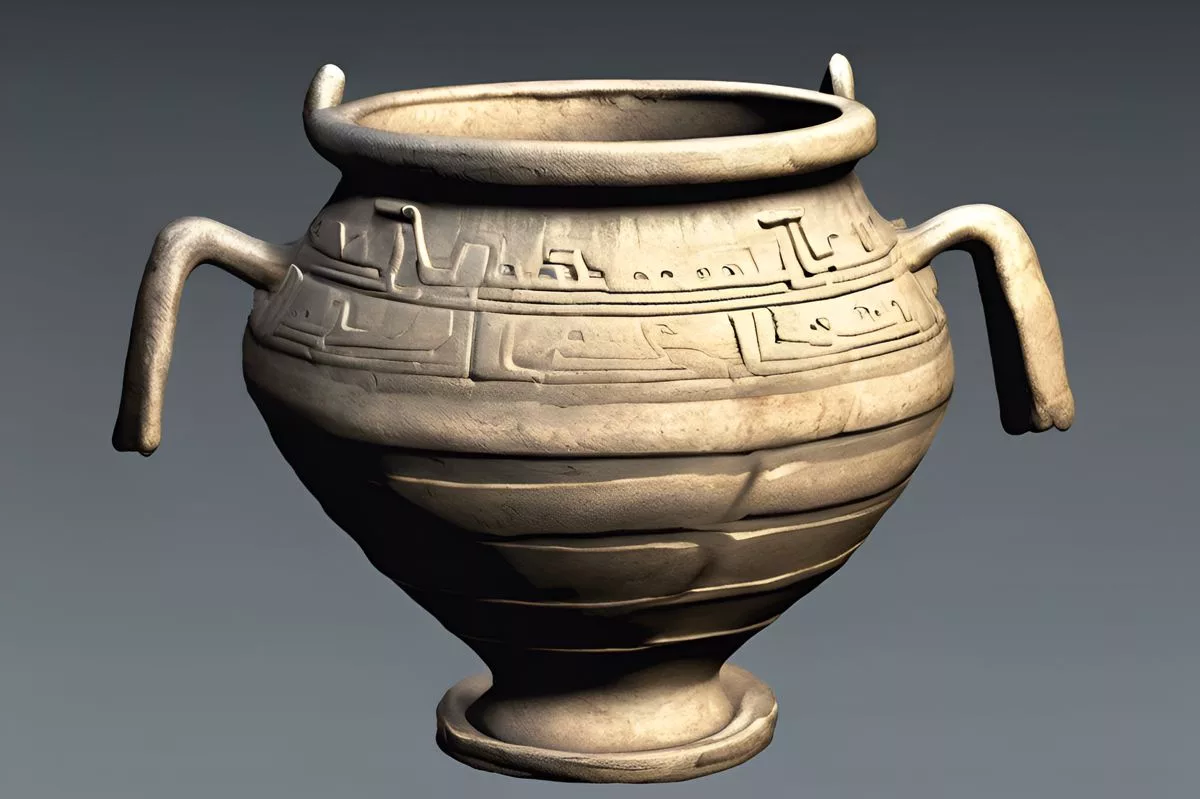A 2,000-year-old pot from the Khoekhoen people has been found at the Kagga Kamma Nature Reserve in the Western Cape, South Africa. The pot, believed to have been used for cooking, is made of red ochre clay and shows evidence of scorch marks. The discovery is a window into the cultural practices and human resilience of the Khoekhoen people and their co-existence with hunter-gatherer societies. Plans are being developed to create a 3D model of the pot for educational purposes and public awareness campaigns.
What is the ancient artifact found at Kagga Kamma Reserve?
An ancient pot estimated to be around two millennia old has been unearthed at Kagga Kamma Nature Reserve in Ceres, Western Cape. The pot is attributed to the Khoekhoen people and bears evidence of scorch marks, suggesting it was used for cooking over an open fire. Its design, reminiscent of an amphora, is indicative of traditional cooking methods and its two intact, horizontally-drilled ‘ears’ suggest it was used for portability. The pot’s discovery is a window into the cultural practices and human resilience of the Khoekhoen people and their co-existence with hunter-gatherer societies.
In the rough and rugged landscape of the Kagga Kamma Nature Reserve nestled in Ceres, Western Cape, an intriguing relic has been unearthed. The artifact, a pot attributed to the Khoekhoen people and estimated to be approximately two millennia old, provides a captivating glimpse into the Late Stone Age culture and survival techniques of the region.
The Discovery and Its Importance
The pot was found hidden beneath a rocky outcrop near a canyon and an intermittent water source. The vigilant visitors, Ivan and Elizma van Niekerk, found the pot and responsibly informed the reserve management. Their swift action allowed the pot to remain untouched until professional archaeologists could recover it, a critical process in maintaining the preservation of the artifact.
The pot was crafted from red ochre clay and bears evidence of scorch marks, suggesting that it was used for cooking over an open fire. Its design, reminiscent of an amphora with a wide opening that tapers into a neck leading to a bulbous body, is indicative of traditional cooking methods where pots were placed directly on fire coals. The structure of the pot base and the pattern of the burn marks corroborate this theory.
The artifact also features two intact, horizontally-drilled ‘ears’ or ‘lugs’, implying that it was likely used for portability, with a cord or string threaded through these lugs for easier handling. Although its size could have restricted its use for long-distance transport, its design might have allowed it to be carried on shoulders.
Unraveling the History of the Artifact
Dr. Vuyiswa Lupuwana, a professor at the University of Cape Town, lauded the excellent preservation of the pot despite the harsh natural environment, attributing it to its high quality. The stylistic elements of the pot align with other archaeological artifacts from the region, confirming its Khoekhoen origins.
The vicinity of the discovery site, littered with stone tools, fragments of ostrich eggshells, and remnants of collapsed roof structures, tantalizingly hint at ancient life. These objects suggest that the indigenous Khoekhoen people resided near hunter-gatherer societies during the later stages of the Stone Age. The remnants of their co-existence are still perceptible in the landscape, narrating the tale of the cultural fusion of that period.
Subsequent examination of the site has uncovered faded rock art galleries adorned with handprints, located just a few meters from where the pot was found. The rock art, supposedly created with traditional ochre-based pigments, further emphasizes the cultural importance and historical richness of the Kagga Kamma Nature Reserve.
Ongoing Research and Future Plans
Tanya Steenkamp, the General Manager at Kagga Kamma, expressed her pleasure at collaborating with the University of Cape Town and Heritage Western Cape. She conveyed hope that further research would unveil more about the lives of early hunter-gatherers and pastoralists that once roamed these vast plains.
The Kagga Kamma Nature Reserve deserves recognition for its efforts to preserve this invaluable historical artifact and invest in additional research. Plans are being formulated to develop a 3D model of the pot using photogrammetry techniques to aid in educational endeavors and public awareness campaigns. This digital replica will facilitate a detailed study of the pot without causing any harm to the original object.
An Age-Old Reflection of Cultural Practices and Human Resilience
This artifact from Kagga Kamma is more than just an archaeological discovery; it is a window into our collective past. It provides not only an invaluable insight into the cultural practices of the Khoekhoen people but also narrates a tale of human resilience and innovation amidst a harsh and demanding environment. The pot, with its scorch marks and lugs, tells a story of communal feasts, shared wisdom, and the simple yet ingenious solutions of our ancestors.
In short, the archaeology of Kagga Kamma serves as a tribute to the human spirit, mirroring our shared heritage and journey etched in clay and stone. It reminds us of our evolutionary journey as a species and the extraordinary journey that awaits us. The story is still being written, each new chapter bringing us closer to understanding our roots and the relentless spirit of our ancestors.
Who found the ancient artifact at Kagga Kamma Reserve?
The pot was found by visitors Ivan and Elizma van Niekerk who discovered it hidden beneath a rocky outcrop near a canyon and an intermittent water source in Kagga Kamma Nature Reserve.
What is the estimated age of the ancient pot found at Kagga Kamma Reserve?
The pot is estimated to be around 2,000 years old.
What is the material of the ancient pot and what evidence does it bear?
The pot is made of red ochre clay and bears evidence of scorch marks, suggesting that it was used for cooking over an open fire. Its design, reminiscent of an amphora, is indicative of traditional cooking methods where pots were placed directly on fire coals. The structure of the pot base and the pattern of burn marks corroborate this theory.
What is the significance of the ancient pot?
The discovery of the pot is a window into the cultural practices and human resilience of the Khoekhoen people and their coexistence with hunter-gatherer societies. It provides valuable insights into the lives and practices of early hunter-gatherers and pastoralists that once roamed the Kagga Kamma Nature Reserve.
What are the future plans for the ancient pot?
Plans are being formulated to create a 3D model of the pot using photogrammetry techniques to aid in educational endeavors and public awareness campaigns. This digital replica will facilitate a detailed study of the pot without causing any harm to the original object.
What does the Kagga Kamma artifact tell us about human history?
The Kagga Kamma artifact provides a glimpse into our collective past and the story of human resilience and innovation amidst a harsh and demanding environment. It is a reminder of our evolutionary journey as a species and the extraordinary journey that awaits us.












